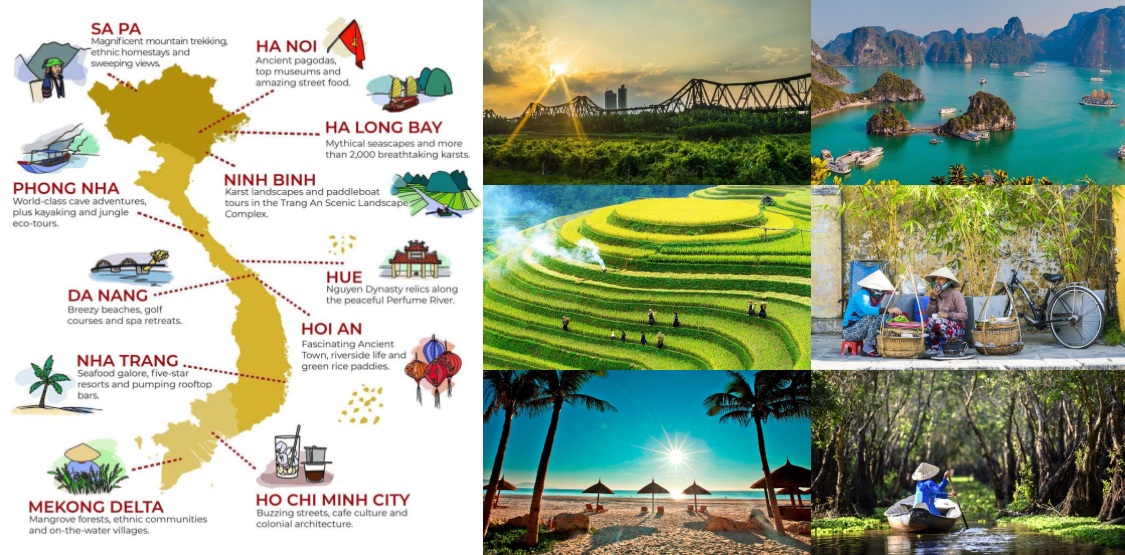Vietnam is a beautiful destination of breathtaking landscapes, rich history, vibrant culture, and delectable cuisine. Planning a trip to this lovely country can be an exciting and rewarding experience, but it also requires careful preparation to make the most of your visit. From choosing the best time to travel to arranging transportation and must-see places, this comprehensive guide will assist you in creating a memorable journey to Vietnam.
1. Research and Choose the Best Time to Visit
Understanding Vietnam’s diverse climate is key to choosing the perfect time for your trip. The country has three main regions: North, Central, and South, each with distinct weather patterns.
* Northern Vietnam (Hanoi, Sapa, Halong Bay, Ninh Binh) experiences four seasons. Spring (March – April) and autumn (September – November) are ideal with mild temperatures and blooming landscapes. Summer (May – August) is quite hot, and winter (December – February) can be chilly, particularly in the mountainous areas.

* Central Vietnam (Hue, Hoi An, Da Nang) has a tropical climate with a distinct dry season from February to August and a rainy season from September to January. To explore the region’s pristine beaches and historical sites comfortably, do visit during the dry season.

* Southern Vietnam (Ho Chi Minh City, Mekong) features two seasons. The dry season (December – April) offers pleasant weather, while the rainy season (May – November) brings occasional showers but also lush, green landscapes.

2. Arrange Travel Documents
Ensure you have the necessary travel documents before embarking on your Vietnam adventure. Citizens of many countries can obtain an E-visa, while others may need to apply for a visa at the Vietnamese embassy or consulate in their home country. Verify your passport’s validity to avoid any last-minute complications and Ensure that your passport validity is at least six months beyond your intended departure date.

3. Craft a Flexible Itinerary
Vietnam’s allure lies in its diversity, so crafting a well-rounded itinerary will help you experience the best the country has to offer. Identify the destinations you wish to visit and allocate sufficient time to explore each place without feeling rushed. Some must-visit spots include:
Hanoi: The historical capital city with a charming mix of the old and new.
Halong Bay: A UNESCO-listed natural wonder featuring emerald waters and limestone karsts.
Hue: Former imperial city, boasting ancient citadels, temples, and royal tombs.
Sapa: A breathtaking mountain town famed for its terraced rice fields and ethnic hill tribes.
Hoi An: A laid-back town known for its lantern-lit streets, ancient architecture, and vibrant markets.
Ho Chi Minh City: The bustling metropolis brimming with energy, history, and modernity.
Mekong Delta: The maze of waterways with lively floating markets, and lush countryside.
4. Book Accommodations in Advance
As Vietnam’s popularity as a travel destination grows, reserving accommodations in advance is advisable, especially during the peak season. Choose lodging that aligns with your likings and budget. Whether it’s a luxury hotel, cozy guesthouse, or immersive homestay, Vietnam caters to various preferences.

5. Plan Transportation Wisely
Vietnam boasts a well-developed transportation network, allowing you to choose from diverse alternatives based on your fondness and budget:
Domestic Flights: Quick and convenient for long distances between major cities.
Trains: A scenic and authentic way to experience the countryside.
Buses: Affordable and available across the country, but consider the longer travel times.
Motorbikes: Adventurous travelers can rent motorbikes to explore specific regions.
6. Embrace the Local Culture
Immerse yourself in Vietnam’s rich culture to enhance your travel experience and foster meaningful connections with the locals:

Respectful Dress: Dress modestly, especially when visiting temples and religious sites.
Local Etiquette: Remove your shoes when entering someone’s home or a place of worship.
Basic Vietnamese Phrases: Learn a few simple phrases to show appreciation and engage with local people.
Gesture of Giving: When giving or receiving something, use both hands as a sign of respect.
7. Sample Vietnamese Cuisine
Vietnam is renowned for its flavorsome cuisine, which varies from region to region. Don’t miss the opportunity to sample some iconic dishes such as pho (noodle soup), banh mi (Vietnamese sandwich), goi cuon (spring rolls), and fresh seafood from coastal cities. Be adventurous and try street food, but ensure it’s prepared in a clean and hygienic environment.

8. Pack Smart and Light
Packing appropriately is essential for a comfortable vacation. Depending on your travel period and destinations, consider the following notes:
Lightweight and breathable clothing for the hot and humid weather.
A light jacket or layers for cooler evenings and highland regions.
Comfortable walking shoes for city exploration and nature treks.
A hat, sunglasses, and sunscreen for protection against the strong sun.
Insect repellent for outdoor activities and rural areas.


